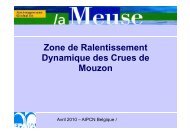PIANC E-Magazine - PIANC AIPCN welcome
PIANC E-Magazine - PIANC AIPCN welcome
PIANC E-Magazine - PIANC AIPCN welcome
You also want an ePaper? Increase the reach of your titles
YUMPU automatically turns print PDFs into web optimized ePapers that Google loves.
Figure 1. Failure modes of a mound breakwater [Bruun, 1985]<br />
Two processes help to understand the forces<br />
that act on a crown wall: run up and overtopping.<br />
Both phenomena are affected by the armour unit<br />
placed in the main layer. Therefore, it is necessary<br />
to conduct further studies into the crown wall behaviour<br />
with different armour units: Cubic blocks<br />
and Cubipods.<br />
The Cubipod (figure 2) is a prefabricated concrete<br />
block designed to protect marine structures<br />
[Gómez-Martín and Medina, 2007]. The Cubipod<br />
overcomes the disadvantages of the cube while<br />
keeping its advantages: great structural resistance,<br />
simple manufacture and placement, flexible<br />
response to extreme storms, high hydraulic<br />
stability and avoiding the tendency face to face.<br />
The simple protrusion-faced design eliminates the<br />
problem of heterogeneous packing, increasing<br />
the friction with the secondary layer. In addition,<br />
thanks to these protrusions, Cubipod layers display<br />
a rougher surface than cube layers, offering<br />
greater resistance to water rise, while decreasing<br />
run-up, overtopping and forces on the crown wall.<br />
Furthermore, the shape of the Cubipod allows for<br />
the use of constructive methods like those used<br />
in nowadays in cubes with minor modifications.<br />
Corredor et al. (2008) created a flanhole formwork<br />
allowing Cubipod manufacture with outputs similar<br />
to cubes. The formwork consists of two elements:<br />
a static base and a top formwork with six articulated<br />
elements to fill and vibrate in two phases which<br />
are removed after every six hours.<br />
1.1. Wave Action on Crown Walls<br />
Figure 2. The Cubipod<br />
The action of waves on the crown wall of a mound<br />
breakwater is highly influenced by the process<br />
of transformation and breaking conditions of the<br />
rough slope. As the wave approaches the slope,<br />
the fast reduction of the depth and friction with the<br />
bottom makes waves increase in steepness, until<br />
they finally break.<br />
If the waves break by plunging or collapsing, then<br />
a great amount of energy is dissipated in the<br />
slope, transmitting little energy to the crown wall.<br />
In addition, when a wave breaks over the porous<br />
slope, a certain amount of air becomes trapped in<br />
the wave in the form of bubbles. The irregularity of<br />
real swell and the theoretical complexity of these<br />
processes mean that there is currently no precise<br />
and reliable analytical model to predict forces on<br />
crown walls. Therefore, to estimate the forces on<br />
<strong>PIANC</strong> E-<strong>Magazine</strong> n° 144, November/novembre 2011 30




